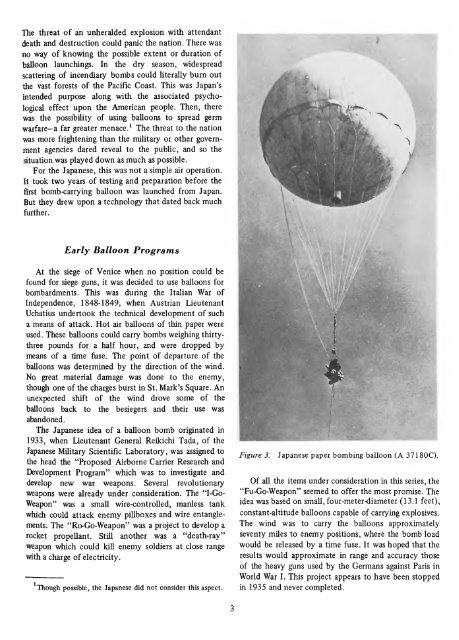Balloon Bomb - Smithsonian Institution Libraries
Balloon Bomb - Smithsonian Institution Libraries
Balloon Bomb - Smithsonian Institution Libraries
Create successful ePaper yourself
Turn your PDF publications into a flip-book with our unique Google optimized e-Paper software.
The threat of an unheralded explosion with attendant<br />
death and destruction could panic the nation. There was<br />
no way of knowing the possible extent or duration of<br />
balloon launchings. In the dry season, widespread<br />
scattering of incendiary bombs could literally burn out<br />
the vast forests of the Pacific Coast. This was Japan's<br />
intended purpose along with the associated psychological<br />
effect upon the American people. Then, there<br />
was the possibility of using balloons to spread germ<br />
warfare—a far greater menace. 1 The threat to the nation<br />
was more frightening than the military or other government<br />
agencies dared reveal to the public, and so the<br />
situation was played down as much as possible.<br />
For Hie Japanese, this was not a simple air operation.<br />
It took two years of testing and preparation before the<br />
first bomb-carrying balloon was launched from Japan.<br />
But mey drew upon a technology that dated back much<br />
further.<br />
Early <strong>Balloon</strong><br />
Programs<br />
At the siege of Venice when no position could be<br />
found for siege guns, it was decided to use balloons for<br />
bombardments. This was during the Italian War of<br />
Independence, 1848-1849, when Austrian Lieutenant<br />
Uchatius undertook the technical development of such<br />
a means of attack. Hot air balloons of thin paper were<br />
used. These balloons could carry bombs weighing thirtythree<br />
pounds for a half hour, and were dropped by<br />
means of a time fuse. The point of departure of the<br />
balloons was determined by the direction of the wind.<br />
No great material damage was done to the enemy,<br />
though one of the charges burst in St. Mark's Square. An<br />
unexpected shift of the wind drove some of the<br />
balloons back to the besiegers and their use was<br />
abandoned.<br />
The Japanese idea of a balloon bomb originated in<br />
1933, when Lieutenant General Reikichi Tada, of the<br />
Japanese Military Scientific Laboratory, was assigned to<br />
the head the "Proposed Airborne Carrier Research and<br />
Development Program" which was to investigate and<br />
develop new war weapons. Several revolutionary<br />
weapons were already under consideration. The "I-Go-<br />
Weapon" was a small wire-controlled, manless tank<br />
which could attack enemy pillboxes and wire entanglements.<br />
The "Ro-Go-Weapon" was a project to develop a<br />
rocket propellant. Still another was a "death-ray"<br />
weapon which could kill enemy soldiers at close range<br />
with a charge of electricity.<br />
Though possible, the Japanese did not consider this aspect.<br />
Figure 3. Japanese paper bombing balloon (A 37180C).<br />
Of all the items under consideration in this series, the<br />
"Fu-Go-Weapon" seemed to offer the most promise. The<br />
idea was based on small, four-meter-diameter (13.1 feet),<br />
constant-altitude balloons capable of carrying explosives.<br />
The wind was to carry the balloons approximately<br />
seventy miles to enemy positions, where the bomb load<br />
would be released by a time fuse. It was hoped that the<br />
results would approximate in range and accuracy those<br />
of the heavy guns used by the Germans against Paris in<br />
World War I. This project appears to have been stopped<br />
in 1935 and never completed.
















